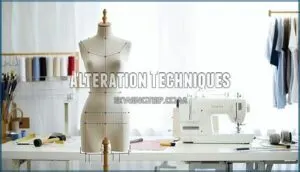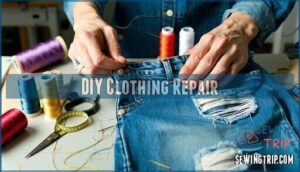This site is supported by our readers. We may earn a commission, at no cost to you, if you purchase through links.
 Your closet’s full of clothes that don’t quite fit right? You’re not alone!
Your closet’s full of clothes that don’t quite fit right? You’re not alone!
Smart sewing ideas for clothing alterations can transform your wardrobe without breaking the bank.
Start simple: hem those too-long pants, take in baggy shirts at the sides, or add darts for a better fit.
Got holes? Turn them into trendy distressed details or patch them with fun fabric.
Transform oversized button-downs into fitted tops by removing sleeves and cinching the waist.
Even worn jeans can become stylish shorts with frayed edges.
These basic alterations breathe new life into forgotten pieces, and once you master these techniques, there’s no limit to what you can create with smart sewing.
Table Of Contents
Key Takeaways
- You’ll transform your wardrobe by mastering basic alterations like hemming pants, taking in baggy shirts at the sides, and adding darts for a better fit—these simple skills save money and keep your favorite pieces wearable.
- You can breathe new life into damaged clothes by patching holes with fun fabric, fixing broken buttons and zippers, and turning worn spots into trendy distressed details instead of throwing them away.
- You’ll create unique pieces by upcycling old clothes—transform oversized button-downs into fitted tops, turn worn jeans into stylish shorts with frayed edges, or add decorative patches for personality.
- You can prevent future alterations by choosing clothes made from synthetic materials that resist shrinking and stretching, maintaining them properly with gentle washing, and buying for your largest measurement then tailoring down.
Clothing Alteration Basics
You don’t need a fancy fashion degree to fix your favorite clothes that are almost perfect but need a little help.
With just a few simple skills like hemming, patching holes, and fixing buttons, you’ll save money and keep wearing the pieces you love instead of tossing them in the donation pile, which helps in fixing your favorite clothes.
Hemming Pants and Jeans
Perfecting hemlines doesn’t require magic—just three simple steps and you’re golden! Start by measuring twice, cutting once, then mark your ideal length with chalk.
Here’s your hemming roadmap:
- Measure accurately using a tape measure and friend’s help
- Mark the hemline with washable chalk or pins
- Cut excess fabric leaving 1-2 inches for folding
- Stitch using blind hems for invisible, professional results
Achieve professional results with a specialized alteration kit. Your jeans alteration adventure begins now!
Fixing Holes and Broken Buttons
Don’t toss that shirt with the missing button or tiny tear! Button replacement starts with perfect thread matching—your secret weapon for invisible repairs.
Don’t let a missing button send your favorite shirt to fashion exile—fix it and wear it with pride!
For holes, patch selection matters: iron-on patches work wonders on cotton, while fabric adhesives handle delicate materials.
Master invisible mending by choosing patch materials that blend seamlessly with your garment’s texture.
These fabric repair techniques turn mending holes into a satisfying skill. Hole fixing becomes second nature once you know these tricks!
Lengthening or Shortening Hems
Broken buttons happen, but wonky hemlines? They’re wardrobe killers. Uneven Hems make even designer clothes look sloppy.
Here’s your hemming game plan:
- Measure twice, cut once—mark your perfect hemline adjustments with chalk
- Blind Hemming creates invisible, professional finishes
- Hem Tape works wonders for quick fixes without sewing
- Consider Fabric Choice—thick denim needs different Hem Finishes than silk
- Practice Measuring Techniques on old clothes first
You’ve got this!
Refashioning Old Clothes
Got a closet full of "meh" clothes? You’re sitting on a goldmine of potential! Refashioning clothes ideas turn yesterday’s mistakes into today’s masterpieces.
That oversized dress collecting dust? Perfect for Dress Refashioning—slice it into a trendy skirt or crop it into a cute top. T-shirt Transformations are your best friend here. Cut sleeves for tank tops, add Creative Embellishments like patches, or twist the back for Instagram-worthy style.
Denim Upcycling breathes life into worn jeans. Turn them into shorts, add Fabric Scraps as colorful patches, or distress them for that expensive "vintage" look.
These upcycling clothing projects aren’t just about saving money—they’re about expressing your unique style. Every creative clothing revamp tells your story. Ready to become the designer your wardrobe deserves?
Upcycling Techniques
You’ve got a closet full of clothes that don’t quite work anymore, but throwing them away feels wasteful—that’s where upcycling swoops in like your creative superhero!
These smart techniques let you transform tired old pieces into fresh new favorites, turning that boring t-shirt into a trendy crop top or those too-long jeans into perfect summer shorts, which is a great way to apply creative thinking.
Turning Old Clothes Into New Ones
Your worn-out wardrobe can become your favorite fashion playground with smart T-shirt Transformations and Denim Upcycling techniques.
Old clothes don’t deserve the donation pile when they can star in amazing refashioning clothes ideas that’ll make your friends jealous.
Here are four game-changing upcycling clothing projects to kickstart your style revolution:
- Transform baggy tees into fitted tanks by removing sleeves and cinching the sides
- Convert tired jeans into trendy shorts with that coveted raw-hem finish
- Turn oversized button-downs into chic crop tops with strategic cutting
- Create stunning patchwork totes from fabric scraps of multiple garments
These clothing customization ideas prove that creative clothing revamp doesn’t require expert skills—just imagination and basic sewing tools.
Adding Skirts or Sleeves
Sleeve additions and skirt alterations can completely transform your wardrobe.
Start with fabric matching – choose colors that complement your existing piece.
For sleeve construction, measure armholes carefully and pin sleeves starting at the side seam.
Skirt attachment works best when you add fabric at the waistline or hem.
Consider style considerations like fabric weight and drape.
These design integration tricks turn boring basics into stunning statement pieces through thoughtful dress lengthening and creative sleeve alteration techniques.
Creating Boutique-Style Dresses
With fabric mixing and lace embellishments, you’ll transform ordinary clothes into boutique-style dresses that rival designer pieces.
Blend patterns, add sparkly beads, or master applique techniques for unique designs that scream "custom couture."
Try these dressmaking ideas:
- T-shirt transformations: Cut and sew basic tees into flowy dresses using elastic waistbands
- Bead application magic: Hand-stitch crystals along necklines for instant glamour
- Mixed-print mastery: Combine florals with stripes for eye-catching dress alteration techniques
Sewing and Mending
You don’t need to toss that favorite shirt just because it has a tiny hole or loose button.
With some basic sewing skills and a few simple tools, you can fix most clothing problems in minutes.
You can keep your wardrobe looking fresh without spending a fortune.
Sewing on Patches and Buttons
While upcycling breathes new life into garments, sometimes you need targeted fixes that make a statement. Patches and buttons transform ordinary clothing into conversation starters.
Patch placement isn’t just about covering holes—it’s about creating stylish fixes. Position decorative patches on elbows, shoulders, or pockets for instant personality. For button replacement, thread matching makes all the difference. Choose contrasting colors for bold statements or exact matches for subtle repairs.
Fabric adhesive works wonders for quick patch sewing jobs, especially on kids’ clothes that can’t wait. However, traditional needle-and-thread methods last longer. Master buttonhole techniques by practicing on scraps first—your finished garments will thank you. Consider using a complete sewing solution to simplify your patch application process.
Here’s your repair roadmap:
Mending Worn-Out Knees and Holes
Once you’ve mastered sewing on patches and buttons, tackling bigger repairs becomes your next adventure. Holes in your favorite jeans don’t spell doom—they’re just another puzzle to solve!
Start with invisible denim patches placed inside the garment. Pin them securely, then stitch diagonal lines across the tear. For stretchy fabric, add fusible interfacing for extra strength. Vinyl knee patches work great for kids’ clothes.
- Patch placement: Use fabric glue for quick positioning
- Shape matters: Oval patches distribute stress better
- Reinforcement: Cut interfacing on bias for stretch
- Layer smart: Thin fabrics prevent bulk
Using Narrow Rolled Hem Foot
After patching knees, you’ll want clean edges on lightweight garments.
The narrow rolled hem foot transforms fraying silk and chiffon into professional finishes. This clever attachment folds fabric twice while stitching—perfect for curve hemming delicate materials.
Adjust your stitch settings to 2.5 length and practice foot adjustments on scraps. You can find a variety of options online.
When troubleshooting hems, remember: this rolled hem technique works magic on thin fabric types only.
Alteration Techniques
You’ll love how these smart alteration tricks can turn that too-loose blazer or tight dress into your perfect fit.
Whether you’re taking in baggy sides, adding darts for shape, or adjusting sleeves that make you look like you’re borrowing from your big brother, these techniques will have you looking like clothes were custom-made just for you, giving you a great shape.
Taking in or Letting Out Sides
Two simple moves can rescue ill-fitting clothes from your donation pile.
Side seam adjustments transform baggy shirts and loose pants into perfectly customized pieces. Waistline alterations cinch droopy waists while fabric insertion expands tight garments.
You’ll resize fabric like a pro with these clothing resizing tricks:
- Mark new seam lines with chalk
- Pin fabric before cutting excess
- Test fit after basting stitches
- Press seams flat when finished
Adding or Removing Darts
Darts shape your silhouette like invisible architects.
Mark dart placement with chalk, considering fabric considerations and dart length.
Fold fabric, sew from wide to narrow end.
Multiple darts work better than one giant dart.
Remove darts by cutting stitches carefully, then press flat.
These clothing alterations transform baggy shirts into fitted favorites through smart seam allowances adjustments.
Lengthening or Shortening Sleeves
Sleeves giving you grief? You’re not alone! Sleeve fabric selection matters—match existing material or go bold with contrasting colors.
Here’s your game plan:
- Mark desired length with pins
- Cut excess fabric, leaving seam allowance
- Fold and press new hem
- Stitch using invisible or straight stitch
- Press final seam for crisp finish
Armhole adjustments work for lengthening, while sleeve folding techniques offer no-sew solutions.
Modern sleeve styling embraces both fitted and relaxed looks!
Measuring and Fitting
You know that frustrating moment when you buy a perfect shirt online, only to discover it fits like a tent or squeezes you like a sausage casing?
Getting your measurements right from the start saves you hours of alteration headaches and keeps your favorite clothes looking amazing for years to come, which is a key factor in maintaining their quality and ensuring they remain your favorite clothes.
Measuring Body and Garment Accurately
Measuring body and garment accurately turns guesswork into garment gold. Your tape measure becomes your best friend when you master these body measurement points. Think of garment ease allowance as breathing room—you need it!
- Master the bustwaisthip basics: Find your fullest points and measure with consistent tape placement
- Movement matters: Bend naturally to locate your true waist for accurate inseam length
- Doublecheck everything: Compare measurements against standard size charts twice
Buying Clothing That Fits
Now that you’ve got your body measurements down pat, let’s talk smart shopping. Body shape awareness becomes your superpower when browsing racks. Always buy for your largest measurement—alteration solutions can handle the rest later.
Check size chart variations between brands because they’re wildly inconsistent. Trying before buying saves headaches and returns. Focus on fit preference styles that flatter your natural silhouette. Pay attention to fabric drape analysis—how material falls on your frame matters more than the number on the tag. Proper garment fit beats perfect sizing every time.
comfort.
customization.
Considering Shrinkage and Stretching
Nobody wants their favorite jeans turning into high-waters after one wash!
Smart sewers know fabric pre-treatment saves headaches later. Understanding fiber content matters – cotton shrinks, spandex stretches out.
Before altering anything, do this garment construction check:
- Run a fabric shrink test on a small corner first
- Master stretchy material care by skipping hot water and high heat
Anticipating changes beats fixing mistakes!
DIY Clothing Repair
When your favorite jeans get a stubborn hole or your go-to jacket’s zipper decides to quit on you, don’t toss them in the donation pile just yet.
You can fix most clothing mishaps at home with basic tools and a few simple tricks that’ll save you money and keep your beloved pieces in rotation.
Fixing Broken Zippers and Buttons
When your favorite jacket won’t zip or a button goes AWOL, you don’t need to retire the garment. These fixes are simpler than folding a fitted sheet!
Start with zipper repair basics. A stuck zipper often needs lubrication—rub a graphite pencil or bar of soap along the teeth. For complete zipper replacement, remove the old one carefully and sew in a new zipper using matching thread.
Button matching matters for a professional look. Save spare buttons from new clothes or visit fabric stores for close matches. Shank buttons need extra thread length to accommodate their stem, while flat buttons sit flush against fabric.
Buttonhole repair involves reinforcing torn edges with matching thread using a tight zigzag stitch.
Master these clothing alterations and you’ll breathe new life into any wardrobe staple.
Patching Tears and Holes
Tears happen to everyone’s favorite clothes—don’t panic! Invisible Patching transforms disasters into victories using smart Fabric Selection and proper Patch Placement.
Here’s your hole mending arsenal:
- Iron-on patches for quick Decorative Patches that add personality
- Denim scraps for sturdy Knee Reinforcement on jeans
- Fusible interfacing for Patch Durability that lasts
Master these clothing repair ideas and watch your wardrobe bounce back stronger than ever!
Maternity Alterations and Jeans Repair
When pregnancy strikes, transform your favorite jeans into maternity jeans with belly panels.
You’ll skip expensive shopping trips while staying comfortable. Denim repair breathes new life into torn favorites too.
| Alteration Type | Emotional Benefit |
|---|---|
| Expanding Waistbands | Freedom from tight clothes |
| Belly Panels | Confidence during pregnancy |
| Jean Mending | Pride in sustainable choices |
| Postpartum Alterations | Joy in wearing favorites again |
These clothing alterations deliver pregnancy comfort and denim durability that lasts.
Preventing Alterations
You’ll save yourself hours of sewing time and frustration by choosing clothes that fit right from the start and taking care of them properly.
Smart shopping choices and regular maintenance keep your favorite pieces looking great longer, so you won’t need to alter them every few months like that shirt you bought three sizes too big because it was on sale.
This approach helps you maintain your clothes, ensuring they remain in good condition, and by doing so, you avoid the hassle of frequent alterations.
Choosing Clothing Made From Synthetic Materials
Smart fabric choices can save you countless alteration headaches down the road.
Synthetic fabric types like polyester and nylon offer incredible synthetic durability and fabric resistance to shrinking, stretching, and fading.
These stretchy fabrics maintain their shape through countless washes, dramatically reducing alteration frequency.
Here’s why synthetic materials are your wardrobe’s best friend:
- No more surprise shrinkage – your favorite jeans won’t become capris overnight
- Shape retention magic – clothes look fresh after years of wear
- Stain-fighting superpowers – spills wipe away without permanent damage
- Color stays vibrant – no more faded, sad-looking garments
- Budget-friendly wins – fewer trips to the tailor means more money in your pocket
When shopping, check labels for synthetic blends.
Textile science shows these fabric choices resist common wear patterns that typically require alterations.
Your future self will thank you for choosing garments with superior fabric resistance and lower garment maintenance needs.
Regularly Maintaining and Repairing Clothing
Your clothing’s worst enemy isn’t age—it’s neglect.
Prompt repair beats panic shopping when that favorite shirt develops a tiny hole.
Keep fabric knowledge sharp by reading care labels religiously.
Smart storage means hanging delicates instead of cramming them into drawers.
Early patching saves embarrassing blowouts later.
Build laundry habits that protect your investment: wash similar colors together, use gentle cycles for fragile items, and skip the dryer when heat could shrink or damage fabrics permanently.
Extending The Lifespan of Garments
Smart maintenance beats constant clothing alterations every time.
Your garments will thank you for the extra attention, and your wallet will too.
Think of each piece as an investment worth protecting:
- Fabric choice matters: Natural fibers need gentler care than synthetics
- Proper storage prevents wrinkles: Hang delicates, fold heavy knits flat
- Stain removal works best immediately: Don’t let spills become permanent residents
- Rotation strategy saves wear: Give favorites a break between wears
Advanced Alterations
Ready to turn your sewing game up a notch?
These advanced tricks will help you add functional pockets to dresses, master tricky circle skirt hems with bias tape, and create completely personalized pieces.
That’ll have friends asking where you shop, thanks to the ability to create pieces that are truly one-of-a-kind with these advanced tricks.
Adding Pockets and Bands to Dresses
Why settle for pocketless dresses when you can add functional style?
Choose pocket styles that match your dress silhouettes—patch pockets for casual looks, in-seam for sleek lines.
Fabric choices matter: cotton for structure, silk for drape.
Band placement at hems creates visual interest with contrasting colors.
These sewing ideas for clothing alterations transform ordinary dresses into practical masterpieces with banded hem details!
Hemming Circle Skirts With Bias Tape
Circle skirts can drive you crazy with their curved hems! Bias tape saves the day by stretching perfectly around those tricky curves.
Choose single-fold bias tape types for best results. Pin the tape to your skirt’s right side, stitch with 1/4" seam allowance, then fold it inside.
This invisible bias hemming technique prevents puckering while maintaining that gorgeous circle skirt drape. Your clothing alterations just got way easier!
Creating Unique and Personalized Clothing
After perfecting your circle skirt hem, you’re ready to make showstopping pieces that scream "you."
Custom embellishments like hand-painted designs or fabric dyeing transform boring basics into conversation starters.
Try style fusion by mixing patterns or creating unique silhouettes through strategic cuts.
Personalized fit adjustments guarantee your clothing customization reflects your body perfectly.
These upcycling tricks turn your wardrobe into a personalized fashion statement.
Frequently Asked Questions (FAQs)
What are the four different types of alterations?
Don’t put all your eggs in one basket when tackling alterations.
You’ll master four main types: adjusting fit (taking in/letting out), changing length (hemming), repairs (fixing holes/buttons), and refashioning (transforming styles completely).
Is altering clothes worth it?
Yes, altering clothes is absolutely worth it! You’ll save money, reduce waste, and get perfect-fitting garments that flatter your body. Simple alterations like hemming cost less than buying new clothes.
What is the most common type of alteration?
Hemming pants takes the crown as the most common alteration you’ll encounter.
Whether it’s jeans that drag on the ground or dress pants pooling at your ankles, shortening lengths happens constantly in every tailor shop.
How to do alteration at home?
Right when you’re staring at that too-long dress, you’ve got everything needed at home.
Grab scissors, measuring tape, pins, and thread.
Measure twice, cut once, then hem by hand or machine—it’s easier than you think.
What’s the difference between hemming and alterations?
Think of hemming as alterations’ younger sibling.
Hemming only adjusts garment length by shortening or lengthening fabric edges.
Alterations cover everything else—taking in sides, fixing tears, adjusting fit, replacing zippers, and transforming entire pieces.
How to easily alter clothes?
Complex tailoring versus simple fixes—you’ll master basic alterations easily.
Start with hemming pants, sewing loose buttons, and patching small holes.
Use a seam ripper, measuring tape, and matching thread for professional results.
What is a basic alteration?
A basic alteration adjusts your clothes’ fit or length without changing their fundamental design.
You’re tweaking what’s already there – shortening sleeves, hemming pants, taking in seams, or replacing buttons for better comfort, which involves making small changes to achieve a more comfortable fit.
How can I make my clothes fit better without sewing?
Your wardrobe doesn’t need surgery to fit perfectly!
Grab safety pins for quick cinches, use hair ties to extend tight waistbands, or add belt loops with fabric tape.
These clever tricks transform loose clothes instantly.
How can I resize a knitted sweater?
Shrinking a knitted sweater requires careful handling.
Wash it in hot water, then toss it in the dryer on high heat.
For stretching, soak in lukewarm water with hair conditioner, then gently pull to desired size.
What’s the best way to alter leather?
Like taming a wild horse, leather needs special care.
You’ll want sharp tools, leather needles, and strong thread.
Work slowly, use clips instead of pins, and condition afterward to keep it supple and beautiful.
Conclusion
Like a magician pulling rabbits from a hat, you’ve discovered how simple sewing ideas for clothing alterations can completely transform your wardrobe.
You’ll save money, reduce waste, and create clothes that fit perfectly.
Start with basic hems and simple repairs, then work your way up to more creative projects.
Don’t let ill-fitting clothes gather dust anymore. Grab your needle and thread, and begin turning those forgotten pieces into your new favorite outfits today.
- https://www.sewsimplehome.com/2019/09/original-hem-jeans.html
- https://www.heatherhandmade.com/how-to-mend-hole/
- https://peekaboopatternshop.com/our-blog/how-to-hem-a-circle-skirt
- https://littlelizardking.com/blogs/little-lizard-king-blog/2018-9-14-hemming-a-circle-skirt?srsltid=AfmBOoqzgBLadZ3L8TkNp3dyp2s38OPGdYX_ru2ev53tuY5Tp-1BpxNI
- https://sewing.patternreview.com/SewingDiscussions/topic/130344















